Slovakia’s house prices down - again!
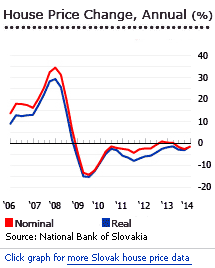 Slovakia’s average residential property prices fell by 1.53% (-1.45% in real terms) y-o-y to Q1 2014, to €1,221 (US$ 1,664) per square metres (sq. m.), according to the National Bank of Slovakia (NBS). This is the third consecutive quarter of price declines, following a slight recovery from Q4 2012 to Q2 2013.
Slovakia’s average residential property prices fell by 1.53% (-1.45% in real terms) y-o-y to Q1 2014, to €1,221 (US$ 1,664) per square metres (sq. m.), according to the National Bank of Slovakia (NBS). This is the third consecutive quarter of price declines, following a slight recovery from Q4 2012 to Q2 2013.
Slovakia’s house prices are now 21% below their peak in Q2 2008 (-29.8 in real terms).
During the past year to Q1 2014:
- Villas had a biggest y-o-y price drop, by around 4.83% (-4.75% in real terms) to €1,911 (US$ 2,605) per sq. m.
- Houses fell 2.21% (-2.13% in real terms) to €1,108 (US$ 1,510) per sq. m.
- Flats had the lowest y-o-y price decrease in Q1 2014, declining by only 0.77% (-0.69% in real terms) to €1,288 (US$ 1,756) per sq. m.
However in comparison to the previous quarter, property prices in Slovakia actually rose by 0.49% (also 0.49% in real terms) q-o-q in Q1 2014.
Bratislava region, which has the most expensive house prices in Slovakia, was one of the regions with smaller price declines at 1.08% (-1% in real terms) to €1,652 (US$ 2,252) per sq. m. Other regions with small price drops include: Nitra (-0.68%), Trencin (-1.40%), and Trnava (-1.90%). Only Zilina region saw property prices increase by about 1.27% (1.36% in real terms) to €795 (US$ 1,084) per sq. m. during the year to Q1 2014.
Regions with biggest residential price declines:
- Kosice: price decline of 6.39% (-6.31% in real terms) y-o-y to €894 (US$ 1219) per sq. m. in Q1 2014.
- Banska Bystrica: 3.56% y-o-y fall (-3.48% in real terms) to €731 (US$ 996) per sq. m.
- Presov: 3.48% y-o-y fall (-3.40% in real terms) to €777 (US$ 1,059) per sq. m. during the same period.
A new face in the Presidency
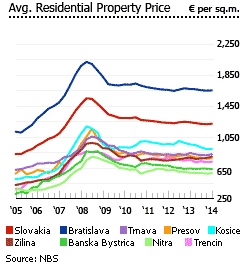
Slovakia’s new President Andrej Kiska was elected in March 2014, and will assume office on June 15, 2014. A political newbie, Kiska defeated current Prime Minister Robert Fico (Smer) and will replace Smer ally Ivan Gašparovič.
He is an independent, with a background as a philanthropist and entrepreneur. He is also the first Slovak president with no communist past. Kiska won decisively in the second round of the 2014 elections, receiving nearly 60% of the vote.
However, the presidency is largely a ceremonial office, though Kiska hopes to create a more healthy balance of power between president and the Cabinet, as well as the strengthening of the Judiciary’s independence.
Slovakia’s recent disappointing growth
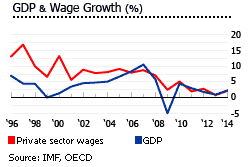
Slovakia is one of Eastern Europe’s most successful transition countries. Born in 1993 after seceding amicably from the Czech Republic (the two countries were formerly known as Czechoslovakia), it has a stable polity and liberal market economy.
Slovakia benefited from eight years’ reform under the centre-right coalition led by Mikulas Dzurinda (1998-2004) whose reforms won praise from international organizations, and who oversaw EU and Nato entry.
The economy’s rapid growth facilitated the country’s membership of the Organization for Economic Cooperation and Development (OECD) and the European Union (EU) in 2004. In December 2007 Slovakia became a full member of the Schengen Zone, allowing passport-free travel in the 24-member European nations.
Real GDP growth reached an impressive 10.5% in 2007, following 8.3% for 2006, 6.7% for 2005, and 5.1% for 2004. Kia, Volkswagen, and Peugeot Citroen all have large car plants in Slovakia.
Since then, Slovakia has had two terms under the socialist and populist leader Robert Fico, of the Smer party (prime minister 2006-2010, and 2012 to present).
Fico’s stewardship has been marked by tension with Hungary, populism towards Slovakia’s Roma population, and weaker economic growth
In 2008 there was 5.8% growth, and then a collapse with the crisis and a 4.9% GDP contraction in 2009. Slovakia’s economy then recovered with GDP growth of 4.4% in 2010, but this was followed by 3 weak years, with 3% GDP growth in 2011, 1.8% in 2012 and only 0.9% in 2013.
Good news: Slovakia’s economy is now recovering

Slovakia’s economy is recovering, with 1.5% GDP growth during the year to Q4 2013. And the recovery is gaining momentum, with 2.4% y-o-y growth in Q1 2014.
The IMF and the European Commission expect the economy to expand by 2.3% this year on improving domestic demand, following a 0.9% slowdown in 2013.
Unemployment fell 1.45% y-o-y to 12.96% in April 2014, according to the Labour, Social Affairs and Family Centre (ÚPSVaR), in line with PM Robert Fico’s cabinet’s priority to reduce unemployment to the eurozone level in 2016.
“The positive trend is being helped by a recovery in Slovakia’s most important export markets, stable domestic demand and an absence of new negative intervention in the market environment,” according to the recruitment consultancy McROY Group’s Ľuboš Sirota.
Very small rental market
Around 9.8% of Slovakia’s population are tenants. But only 0.1% of Slovakia’s housing stock is let out by private landlords, mainly in Bratislava.
The country has the third highest rate of homeownership in the EU, with an owner occupancy rate of 90.2% in 2011, a sharp increase from 49.7% in 1990, largely due to the rent control system.
The growth of owner-occupation is partly due to a contractual savings system (Bauspar) that makes it easy for Slovaks to obtain housing loans. This Bauspar system allows borrowers to take loans at lower interest rates, and the government pays an interest premium on the amount saved.
In 2005, the government decreed the abolition of rent control, effective July 1, 2007. However, the decree was never implemented. Rent deregulation has been postponed repeatedly, as Parliament refuses to deal with the highly sensitive issue.
Lower yields and rents
Slovakia’s rental market experienced further declines in rents and yields in 2013.
Based on Global Property Guide research in July 2013, in Stare Mesto, Bratislava’s city centre:
- Gross rental yields on larger units such as 120 sq. m. and 200 sq. m. apartments fell to around 4.94% and 4.53%, respectively.
- Smaller units of 75 sq. m. have slightly higher yields, at 5.4%.
- Outside Bratislava’s Old Town, THE less upscale districts of Ruzinov and Nove Mesto (Bratislava II & III), have higher gross rental yields than Stare Mesto.
- The average yield in Stare Mesto fell to 5% in July 2013, from 5.2% the previous year, while the average yield in Bratislava II and III dropped from 5.7% to 5.6%.
The average rent in Stare Mesto declined by 3.4% year-on-year to €1,164 per month in July 2013. Bratislava II and III experienced a sharper fall from €1,061 to €919 per month for 120 sq. m. apartments, perhaps because of a shift to smaller apartments, whose rents do not seem to have fallen.
This drop in rents in the recent years is also attributable to increased housing supply around Bratislava. Last year 2,258 new apartments were sold in Bratislava, a 14.2% increase compared with 2012 which, admittedly, was a weak year.
AVERAGE RESIDENTIAL PROPERTY PRICES |
||||
CHANGE |
||||
| SLOVAKIA | ||||
| REGIONS | ||||
| Bratislava | ||||
| Trvana | ||||
| Nitra | ||||
| Trencin | ||||
| Zilina | ||||
| Banska Bystrica | ||||
| Kosice | ||||
| Presov | ||||
| PROPERTY TYPE | ||||
| Total flats | ||||
| 1 - room | ||||
| 2 - rooms | ||||
| 3 - rooms | ||||
| 4 - rooms | ||||
| 5 - rooms | ||||
| Total houses | ||||
| Houses | ||||
| Villas | ||||
| Source: National Bank of Slovakia | ||||
Interest rates are low, and could fall further
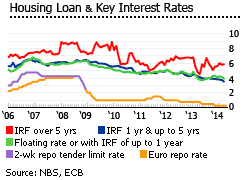
Slovakia’s average loan rates are low, due to European Central Bank (ECB) rate cuts. Since December 2011, the ECB has had 4 rate cuts, two in 2013 (May and November), leading to a historic low official interest rate of 0.25%.
Mortgage rates in Slovakia now:
- Floating rate, or with IRF of up to 1 year – 3.94%
- IRF over 1 and up to 5 years – 3.54%
- IRF over 5 years – 5.87%
ECB President Mario Draghi has hinted that the ECB may further cut rates, as euro area inflation now stands at only 0.7% (April 2014).
Yet these rate cuts seem to have had limited effects in Slovakia, as banks have become very cautious in their lending activities. Deflation in Slovakia continued for the third consecutive month in April 2014, with inflation declining by 0.2% y-o-y.
Mortgage market growing
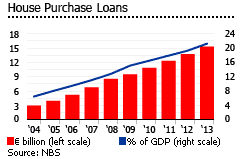
In March 2014, mortgage loans in Slovakia reached €6.95 billion (US$ 9.49 billion), up by 7.5% from the €6.48 billion (US$ 8.83 billion) recorded in March 2013, according to the NBS.
The volume of housing loans to households saw average growth of 30% annually from 2005 to 2008. However, the annual average growth rate of housing loans was reduced by more than half, to around 12.4% annually from €9.5 billion (US$ 12.95 billion) in 2009 to €15.3 billion (US$ 20.85 billion) in 2013.
End of the flat tax
One of the most famous characteristics of the Slovak economy was previously its ‘flat tax’ of 19% on income, consumption, and corporate profits, operative since 2004. “It just works!” explained former minister of finance Ivan Miklos to a Cato Seminar. However, Slovakia’s parliament scrapped the flat tax from January 1, 2013, raising income tax for corporations to 23% and for individuals earning more than €3,300 (US$ 4,498) per month to 25%.